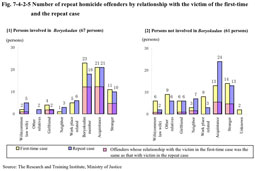| Previous Next Index Image Index Year Selection | |
|
|
3 Relationship with victim
The relationship between the repeat homicide offender and their victim is reviewed with the first-time and repeat cases. The number of repeat homicide offenders and their relationship with the victim is categorized by the relationships as seen in Fig.7-4-2-5; spouse (including common law spouse), girlfriend, acquaintance, neighbor and others.
Fig. 7-4-2-5 Number of repeat homicide offenders by relationship with the victim of the first-time and the repeat case Regarding offenders involved in Boryokudan (hereinafter referred to as “Boryokudan offenders” in this chapter), many cases involved a conspiracy with a fellow Boryokudan member and the victim being an acquaintance. On the other hand, where the offender was not involved in Boryokudan (hereinafter referred to as the “non-Boryokudan Offenders” in this chapter), those cases committed against an acquaintance or stranger were conspicuous. The percent ratio of the cases of the relationship between offender and victim being the same for the first-time case and the repeat case (for example, the victim was an acquaintance both in the first time case and second time case) was the highest for cases with the victim being an acquaintance (57.1%), followed by cases with the victim being a Boryokudan members (52.2%), spouse/ common law spouse (50.0%); girlfriend (50.0%), regarding the Boryokudan offenders. Likewise, with the non-Boryokudan offenders, the ratio was the highest for cases with the victim being a neighbor (66.7%), followed by cases with the victim being an acquaintance (53.8%), then stranger (42.9%).Disregarding whether the offender was involved in Boryokudan or not, it is found that half or more of those whose victim in the first-time case had been an acquaintance, the relationship with the victim was the same in the repeat case. In many of these cases, “anger/strong emotion” was the criminal motive or cause. |
